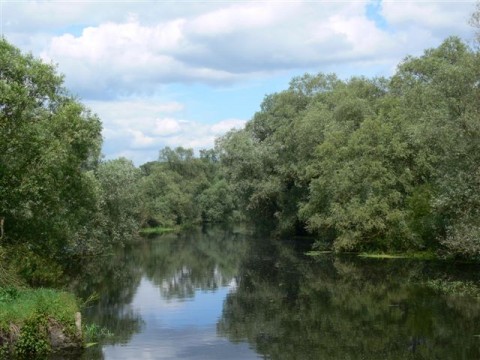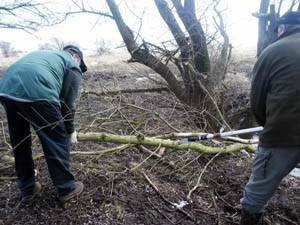

Photos: Mr Berbig

Project: Concept for developing softwood floodplains as part of environmentally friendly flood protection measures along federal waterways
Softwood floodplain forests
Softwood floodplain forests used to edge the watercourses in Central Europe. Mankind’s interference, most particularly in terms of agricultural, developmental and recreational use, has resulted in these being the most endangered types of forest communities. Hence, softwood floodplain forests are categorized in Annex I of the Flora-Fauna Habitat Directive as a priority habitat “Alder-ash forests and softwood floodplain forests along watercourses”. According to Section 30 of the Nature Conservation Law of Saxony-Anhalt they are categorized as especially protected biotopes. In the Elbe landscape in Saxony-Anhalt, softwood floodplain forests make up no more than 0.3% of the area (Elbe Species and Biotope Conservation Programme).
Natural softwood floodplain forests along the Elbe consist of the dendriform willow species white willow (Salix alba) and Hutchinson’s yellow (Salix rubens) and the bush-like willow species almond leaved willow (Salix triandra) and basket willow (Salix viminalis). The highly at-risk black poplar (Populus nigra) can also be found at higher locations. Natural locations form the virgin soils that are regularly and perpetually submerged along the riverbanks.
In addition to their insufficient distribution, softwood relicts exhibit special deficits in terms of their age structure and genetic variation.
Because they are so rare and endangered, softwood floodplain forests should be conserved and propagated in the Elbe Valley. However special demands made by flood management must also be taken into consideration. In particular, when new plantings are made in flood areas, proof of the location’s so-called flood neutrality is called into question. At times demands are made (and have already been carried out) to clear floodplains of forests as an alleged flood control measure.
Project description
These issues were highlighted in the project, funded by the German Federal Foundation for the Environment, to create a “concept for developing softwood floodplains as part of environmentally friendly flood protection measures along federal waterways”.
The aim of the project was to develop and implement a practical concept for establishing softwood floodplains along federal waterways that were rich in structure and genetic resources while ensuring protection against flooding. The project was to increase the structural diversity in the floodplains, conserve and improve the genetic diversity of the native species of willow and black poplar and improve the functionality of floodplain habitats while ensuring protection against flooding.
The project began in 2005 and ended in 2010.
Project partners included:

Department of Nature Conservation
at the University of Marburg

Institute of Water and River Basin Management
at the University of Karlsruhe

Kyritz Forestry office

German Federal Foundation for the Environment

Middle Elbe Biosphere Reserve
The project encompassed 7000 hectares and stretched nearly 60 river kilometres along the Elbe dyke floodplains from Sandau to Cumlosen on Elbe River Landscape Biosphere Reserve in the states of Brandenburg and Saxony-Anhalt.
Work carried out
In order to collect basic data for model investigations, staff members from the University of Marburg identified occurrences of ideal softwood floodplain habitats and vegetation in the project region using habitat suitability models. The data was then quantified and various structural parameters were established which were needed to analyse the resistance of the softwood floodplain stands under flow conditions. Moreover, genetic analysis of the populations was carried out to establish the reproducibility and genetic diversity of the softwood floodplains. These finding served to estimate their future genetic potential and suitable plant material for establishing replacement and conservation cultures.
At the University of Karlsruhe comprehensive hydraulic test models were performed to determine the hydraulic resistance of different shrub species in order to better assess the impact softwood floodplain locations would have on flooding in the future.
The results of these investigations were used to identify habitats and structures which, from a biotic and hydraulic point of view, are suitable, semi-suitable and unsuitable for softwood floodplain development. In addition a code of practice for establishing softwood floodplains along larger waterways was to be developed by the end of the project.
In order to preserve and improve the gene resources available in the region under investigation, suitable plant material was acquired in the project region by Middle Elbe Biosphere Reserve and the Kyritz Forestry Office. This material was used for re-establishing a total of 10 hectares of softwood floodplain. At the same time the administration of the biosphere reserve supported project implementation on-site.